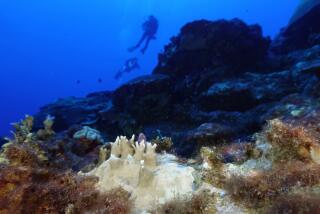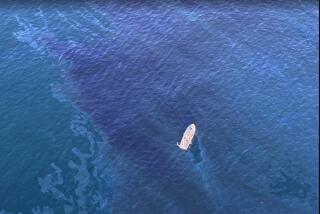Stability Left to Time and Nature in Exxon Valdez Spill
I had visited the beach three times--just after the Exxon Valdez oil spill, during the massive cleanup, and after all cleanup workers had left the coasts of Prince William Sound. On each occasion, I kept my eye on a particular pool of oil. During my most recent visit in mid-September, the mucky pool was still there--unrecovered by recovery technology.
Weathered to the consistency of mud, this oil was a coagulated remnant of the nearly 260,000 barrels of oil the Exxon Valdez spilled into the ocean. According to the state of Alaska, roughly 77,000 barrels were presumed evaporated, 65,000 were recovered (but were an oil and water emulsion) and 114,000 barrels remained unaccounted for.
The unrecovered oil has been left to the winter and to nature. However, as a local resident so aptly summed up for me: “They say nature will take care of things. But even nature has to dispose of the oil somewhere.”
After spending about $1.3 billion and employing as many as 12,000 people, Exxon declared 1,089 miles of beach “environmentally stable” and stopped its active cleanup of Prince William Sound in September. The company planned to leave behind some equipment and personnel to monitor the shoreline and respond to emergencies.
But the “stability” of the beaches may change from one tide to the next.
I saw beaches still bleeding sheens of oil back into the water--oil that had soaked down several feet into gravel and still percolates to the surface. Exxon acknowledges this deep-rooted oil cannot be removed other than by wind, wave and water, the tools of time and tide.
These dynamic natural forces cannot make the oil truly disappear. They can only transfer it to the atmosphere or to the sea, to the feathers of a bird or the eggs of a fish. And for how long and to what effect, nobody knows.
Scientists lack information about the long-term effects of oil, even in small amounts, and consequently the Valdez accident has become a vast experiment. Scientists are asking questions about all aspects of the spill. For example, how much oil do “oil-loving” bacteria actually love? How long does it take an oil-soaked otter to recover the insulating power of its fur after it has been cleaned with household detergent?
The sound has become a global laboratory for cleanup technology, I was told by Otto Harrison, general manager of Exxon’s Valdez office. But I was stunned by two basics he said had not been anticipated by any of the oil companies involved in transporting oil through the Alaska pipeline: namely that when cleaning up so much oil, you need a place to pump it; and that in deploying so much boom--the sausage-like barriers laid out on the water to block the movement of oil--you need to have a system of beepers on the booms that emit radio signals if any part of a boom becomes broken.
These very simple lessons were learned the hard way. But I doubt they have yet been incorporated into any oil spill contingency plan around the world today.
It is true that Exxon mounted a massive effort to attack oiled beaches. At the company’s summation press conference, public relations officers laid out “clean” rocks on a conference table and spoke of how successful the cleanup had been. “I’ll let you pick your definition of clean,” Harrison told the reporters.
But the next day, the Alaska State Department of Environmental Conservation held its summation press conference, and its spokespersons also laid rocks on a table. These stones were covered with oil. Gov. Steve Cowper explained how much of the cleanup still lies ahead. Other state officials circulated a list of “The Dirty Dozen”--beaches that remain ravaged by oil.
At the same time, hundreds of sea birds were still washing up dead on Kodiak Island and, though they showed no external signs of oil contamination, death from oil ingestion was considered likely, according to the state officials with whom I spoke.
Thus the end of the cleanup became a war of rocks and interpretations. Your impressions depended on what beach you visited and with whom you spoke.
“There are no absolutes in this business,” Harrison told me.
Except the likelihood of another accident, I thought.
Just two weeks after Exxon declared its main job over, a tanker owned by British Petroleum (which now holds the controlling interest in the Alyeska Pipeline Service Co. that operates the Alaska Pipeline) lost all engine power in Prince William Sound. The oil-laden vessel was prevented from drifting dangerously close to the same location where the Exxon Valdez ran aground by newly compulsory tugs and escort ships.
It seems inconceivable that the sound could have come so close to another disaster, and we must ask the responsible parties how the ship could fail so fully so soon after leaving harbor. What of maintenance and crew and engine reliability? If there had been an accident, would British Petroleum have admitted fault as readily as Exxon? Would it as readily have taken the consequences?
My intransigent pool of oil didn’t appear on Exxon’s list of beaches admittedly “not OK yet” or on the State of Alaska’s “Dirty Dozen.” It fell between the lists, perhaps like many other corners of a vast ecosystem that escaped inventory or review, neither “stable” nor “clean.”
It remains just what it is--a beach fouled by oil that should never have spilled, a lingering reminder not only of what happened, but what could happen again tomorrow, anywhere in the world, unless we seriously reevaluate our system of transporting oil.
More to Read
Sign up for Essential California
The most important California stories and recommendations in your inbox every morning.
You may occasionally receive promotional content from the Los Angeles Times.










